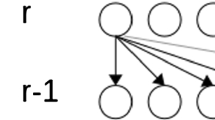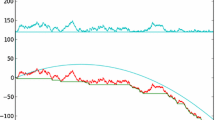Abstract
The mutation process is introduced into the colored coalescent theory. The mutation process can be viewed as an independent Poisson process running on the colored genealogical random tree generated by the colored coalescent process, with the edge lengths of the random tree serving as the time scale for the mutation process. Moving backward along the colored genealogical tree, the color of vertices may change in two ways, when two vertices coalesce, or when a mutation happens. The rule that governs the coalescent change of color involves a parameter x; the rule that governs the mutation involves a parameter μ. Explicit computations of the expectation of the coalescent time (the first hitting time), and the coalescent probabilities (the first hitting probabilities) are carried out. For example, our calculation shows that when x=1/2, for a sample of n colored individuals, the expected time for the colored coalescent process with the mutation process superimposed to first reach a black MRCA or a white MRCA, respectively, is 3−2/n with probability 1/2 for any value of the parameter μ. On the other hand, the expected time for the colored coalescent process with mutation to first reach a MRCA, either black or white, is 2−2/n for any values of the parameters μ and x, which is the same as that for the standard Kingman coalescent process.
Similar content being viewed by others
References
Fu, Y.-X., Li, W.-H., 1999. Coalescing into the 21th century: an overview and prospects of coalescent theory. Theor. Popul. Biol. 56, 1–10.
Hein, J., Schierup, M.H., Wiuf, C., 2005. Gene Genealogies, Variation and Evolution: A Primer in Coalescent Theory. Oxford University Press, London.
Kingman, J.F.C., 1982a. The coalescent. Stoch. Process. Their Appl. 13, 235–248.
Kingman, J.F.C., 1982b. On the genealogy of large populations. J. Appl. Probab. 19A, 27–43.
Nordborg, M., 2001. Coalescent theory. In: Balding, D., Bishop, M., Cannings, C. (Eds.), Handbook of Statistical Genetics. Wiley, New York. Chapter 7.
Rice, S.H., 2004. Evolutionary Theory: Mathematical and Conceptual Foundations. Sinauer, Sunderland.
Rosenberg, N.A., Nordborg, M., 2002. Genealogical tress, coalescent theory and the analysis of genetic polymorphisms. Nat. Rev. Genet. 3, 380–390.
Syski, R., 1992. Passage Times for Markov Chains. IOS Press, Amsterdam.
Tian, J.P., Kannan, D., 2006. Lumpability and commutativity of Markov processes. Stoch. Anal. Appl. 24(3), 685–702.
Tian, J.P., Lin, X.-S., 2005, Colored coalescent theory. Discrete Contin. Dyn. Syst., Sup. Vol., pp. 833–845.
Author information
Authors and Affiliations
Corresponding author
Rights and permissions
About this article
Cite this article
Tian, J.P., Lin, XS. The Mutation Process in Colored Coalescent Theory. Bull. Math. Biol. 71, 1873–1889 (2009). https://doi.org/10.1007/s11538-009-9428-4
Received:
Accepted:
Published:
Issue Date:
DOI: https://doi.org/10.1007/s11538-009-9428-4




